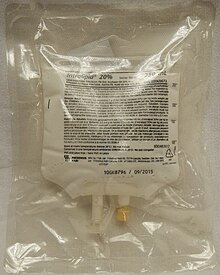| Calcium channel blocker toxicity | |
|---|---|
| Other names | Calcium channel blocker poisoning, calcium channel blocker overdose |
 | |
| A 20% lipid emulsion commonly used for calcium channel blocker toxicity | |
| Specialty | Emergency medicine |
| Symptoms | Slow heart rate, low blood pressure, nausea, vomiting, sleepiness[1][2] |
| Complications | Cardiac arrest[2] |
| Usual onset | Within 6 hours[2] |
| Causes | Too much calcium channel blockers either by accident or on purpose[3] |
| Differential diagnosis | Beta blocker toxicity[1] |
| Treatment | Activated charcoal, whole bowel irrigation, intravenous fluids, calcium gluconate, glucagon, high dose insulin, vasopressors, lipid emulsion[1][2] |
| Prognosis | High risk of death[2] |
| Frequency | > 10,000 (US)[2] |
Calcium channel blocker toxicity is the taking of too much of the medications known as calcium channel blockers (CCBs), either by accident or on purpose.[3] This often causes a slow heart rate and low blood pressure.[1] This can progress to the heart stopping altogether.[2] Some CCBs can also cause a fast heart rate as a result of the low blood pressure.[4] Other symptoms may include nausea, vomiting, sleepiness, and shortness of breath.[2] Symptoms usually occur in the first six hours but with some forms of the medication may not start until 24 after hours.[2]
There are a number of treatments that may be useful.[1] These include efforts to reduce absorption of the drug including: activated charcoal taken by mouth if given shortly after the ingestion or whole bowel irrigation if an extended release formula was taken.[1] Efforts to bring about vomiting are not recommended.[1] Medications to treat the toxic effects include: intravenous fluids, calcium gluconate, glucagon, high dose insulin, vasopressors and lipid emulsion.[1][2] Extracorporeal membrane oxygenation may also be an option.[1]
More than ten thousand cases of calcium channel blocker toxicity were reported in the United States in 2010.[2] Along with beta blockers and digoxin, calcium channel blockers have one of the highest rates of death in overdose.[2] These medications first became available in the 1970s and 1980s.[2] They are one of the few types of medication in which one pill can result in the death of a child.[2]
- ^ a b c d e f g h i Palatnick, Wesley (Feb 2014). "Emergency Department Management of Calcium-Channel Blocker, Beta Blocker, and Digoxin Toxicity". Emergency Medicine Practice. 16 (2): 1–19, quiz 19-20. PMID 24883458. Archived from the original on 2014-05-14.
- ^ a b c d e f g h i j k l m n Marx, John A. Marx (2014). "Cardiovascular Drugs". Rosen's emergency medicine: concepts and clinical practice (8th ed.). Philadelphia, PA: Elsevier/Saunders. pp. Chapter 152. ISBN 978-1455706051.
- ^ a b "Calcium channel blocker overdose". ADAM. 2011-01-19. Archived from the original on 5 April 2014. Retrieved 9 May 2014.
- ^ Wolfson, Allan B. (2010). Harwood-Nuss' clinical practice of emergency medicine (5th ed.). Philadelphia, PA: Lippincott Williams & Wilkins. p. 1454. ISBN 9780781789431. Archived from the original on 15 August 2016. Retrieved 28 July 2016.